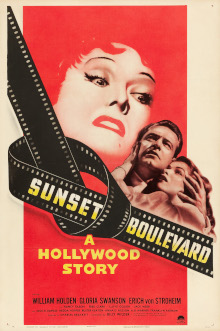- Franz Waxman
Sunset Boulevard: Suite (1950)
- G Schirmer under license to Fidelio Music from Sony / ATV (World)
orch. Leonid Raab, ed. Charles Gerhardt
- 2(I:afl,pic.II:pic).1(ca).3(II:Ebcl.III:bcl).2(II:cbn).[asx]/3[+1].3.3.1/timp.3perc/pf(cel).hp/str
- 7 min 45 s
- 31st December 2025, Marian Anderson Hall, Philadelphia, PA, United States of America
- 12th February 2026, Alys Stephens Center - Jemison Concert Hall, Birmingham, AL, United States of America
Programme Note

Sections
Prelude
Norma Desmond
The Studio Stroll
The Comeback
Norma as Salome
Paramount on Parade
Note
“You see, this is my life! It always will be! Nothing else! Just us, the cameras, and those wonderful people out there in the dark! All right, Mr. DeMille, I’m ready for my close-up!”
From the opening scene, as the camera pulls back from the curb name Sunset Blvd., to the police cars racing down the famous street to the scene of a murder — until that marvelous denouement in the neglected, gothic mansion, as the demented Norma Desmond descends the stairs, and declaims the above dialogue, Franz Waxman’s music thoroughly underlines the film’s ironic themes and brings it to its tragic conclusion. Can it be argued that this, Sunset Boulevard (1950), is Waxman’s musical masterpiece?
Joining again with director and co-writer Billy Wilder, Waxman caught the cruel spirit of this Hollywood on Hollywood story, with its insistent look at the underside of the ‘glamour capitol of the world,’ and Paramount Studios, very much a centerpiece. In addition to Gloria Swanson as Desmond, the film stars William Holden, Erich von Stroheim (as Norma’s former director, husband and now, butler), Nancy Olson and, in a small role as Holden’s friend, Jack Webb. (He, of later Dragnet fame.) Perversely, Holden is dead at the opening, floating face down in the mansion’s swimming pool. Yet, as Joe Gillis, he is the film’s narrator, and carries the audience along in this tale of madness.
Joe: “Yes, this is Sunset Boulevard, Los Angeles, California. It’s about five o’clock in the morning. That’s the homicide squad, complete with detectives and newspaper men…”
Gloria Swanson wasn’t the first choice for the lead female role, the ‘old woman.’ Wilder first approached Greta Garbo (44), who said ‘no,’ Mae West (56), who said, ‘too young,’ Mary Pickford (57), who wanted to control it, and, silent screen star Pola Negri (55), who was upset to be considered a has-been. Then, Wilder approached 52-year-old Gloria Swanson, who had never really connected in the movies’ sound era. When she balked, director and friend George Cukor told her, this is the role for which you’ll be remembered.
Joe: “You’re Norma Desmond. You used to be in silent pictures. You used to be big.”
Norma: “I am big. It’s the pictures that got small.”
Holden was not the first choice. Montgomery Clift was already signed, when he withdrew. Seems he didn’t want to romance an older woman on-screen. Ironically, he was doing that very thing off-screen.
Director Cecil B. DeMille, sometimes called the founder of Hollywood, has a small but critical role in Sunset Boulevard, in a touching sequence where Norma visits him on the set of his latest picture, Samson and Delilah (1949). (DeMille and Swanson had worked together a number of times at Paramount in the silent era.) Although Wilder, at 43, was raising Hollywood’s tattered celluloid curtain, he and the 68-year-old autocratic DeMille got along just fine. “I had an agreement with him”, said Wilder, “I would not tell him how to direct Samson and Delilah. He would not tell me how to direct Sunset Boulevard!” And here’s another, but more subtle connection between Wilder, DeMille and the two films. At a party at Webb’s apartment, Holden uses the phone. Between the phone and the wall is a small model of a statue. It is Dagon, which, in full scale, Victor Mature destroys, along with its temple, in DeMille’s climatic set piece of Samson and Delilah. Was Wilder trying to make some kind of statement?
Waxman’s tango theme for Sunset Boulevard is based on a scene in the film in which Norma Desmond makes reference to a polished floor in her mansion, where Valentino danced the tango. Waxman noted, “[Since] this is the atmosphere in which she lives today (1950), I took this little bit of characterization as inspiration.”
Waxman’s score also includes an inside gag with the theme for Olson’s character, who is in love with Holden. The pair had been working at night in the deserted studio and as they walk the back-lot streets, you hear the lyrical love theme, with its muted trumpet solo. It is a re-working of the strident march theme that, weekly, for 30 years, introduced the Paramount Newsreel, ‘The Eyes and The Ears of the World’! The real Paramount Studios played a major role in Sunset Boulevard, and every scene that shows off the studio, is now a frozen-in-time view of a vanished Hollywood.
In the end, Von Stroheim, flanked by Paramount Newsreel cameras, along with police and reporters, tells the demented Norma, “This is the staircase of the palace,” and Norma descends into madness and cinema history. Waxman accompanies her every step down the staircase transforming the tango theme into a grotesque parody of early film music ending in a cascading shower of notes.
Not all “those wonderful people out there in the dark” were happy with the final results. At an industry screening on the Paramount lot, MGM headman Louis B. Mayer told Wilder, “You have disgraced the industry that made and fed you. You should be tarred and feathered and run out of Hollywood.” Wilder replied with an expletive!
Sunset Boulevard was nominated for eleven Oscars. It won three. Franz Waxman was one of the three. In 2005, Waxman’s score was listed as among the twenty-five most memorable film scores of all time by the American Film Institute.
— Jim Brown

 Located in the UK
Located in the UK
 Located in the USA
Located in the USA
 Located in Europe
Located in Europe
